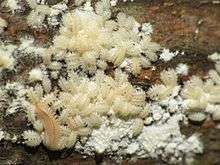Brachycybe
| Brachycybe | |
|---|---|
_millipede_(3680001399).jpg) | |
| Brachycybe lecontii | |
| Scientific classification | |
| Kingdom: | Animalia |
| Phylum: | Arthropoda |
| Class: | Diplopoda |
| Order: | Platydesmida |
| Family: | Andrognathidae |
| Genus: | Brachycybe Wood, 1864 |
| Type species | |
| Brachycybe lecontii Wood, 1864 | |
| Species | |
|
B. cooki | |
| Synonyms | |
|
Sinocybe Loomis, 1942 | |
Brachycybe (Greek for "short head") is a genus of andrognathid millipedes with species in the United States and East Asia. In a rare example of paternal care in invertebrates, males of most species guard the eggs until they hatch.
Description
Brachycybe species are rather similar in appearance, varying in subtle features of the collum (first body segment) and paranota (lateral “keels” extending off of body segments). Individuals attain lengths up to 1 inch (25 mm) and range in color from orange to tan to pink. B. picta is uniquely patterned with 5 brown spots.[1] The 9th and 10th pair of legs in mature males are modified into gonopods (reproductive appendages), and although gonopods are widely used to determine species in millipedes, the relatively simple gonopods of Brachycbe and other members of the Platydesmida show little variation and are not readily useful for species identification.[2]
Ecology
While most millipedes feed on leaf litter or other plant matter, Brachycybe are thought to feed primarily on fungus, and may be found under rotting logs or stumps.


Egg brooding
Male egg brooding (care of eggs) has been extensively studied in B. nodulosa, a species found in Japan and South Korea. After the female lays eggs, the male coils his body around the mass, and guards them until hatching, a behavior thought to protect the eggs from soil-dwelling fungi or predators such as ants.[3]
Species

At least eight species have been named, and at least two undescribed species have been identified by genetic analysis. Studies of genetic differences suggest the genus originated in California around 50 million years ago.[2]
- B. cooki (Loomis, 1942)- Jiangxi Province, China
- B. disticha Mikhaljova et al., 2010. - Taiwan
- B. lecontii Wood, 1864 - Southeastern United States, from Virginia to Illinois and Kansas, south to Louisiana and southern Alabama.
- B. nodulosa Verhoeff, 1935 - Central and Southern Japan, southern South Korea.
- B. petasata Loomis, 1939 - Southern Appalachians: in adjacent parts of North Carolina, Georgia, Alabama, and Tennessee.
- B. picta Gardner, 1975 - Northern California: Marin County and Mendocino County.
- B. producta Loomis, 1939 - Northern California
- B. rosea Murray, 1877 - Northern California
References
| Wikimedia Commons has media related to Brachycybe. |
- ↑ Enghoff, Henrik (2011). "Trans-segmental serial colour patterns in millipedes and their developmental interpretation (Diplopoda)". International Journal of Myriapodology. 6: 1–27. doi:10.3897/ijm.6.1949.
- 1 2 Brewer, Michael S.; Spruill, Chad L.; Rao, Nandita S.; Bond, Jason E. (2012). "Phylogenetics of the millipede genus Brachycybe Wood, 1864 (Diplopoda: Platydesmida: Andrognathidae): Patterns of deep evolutionary history and recent speciation". Molecular Phylogenetics and Evolution. 64 (1): 232–242. doi:10.1016/j.ympev.2012.04.003.
- ↑ Kudo, Shin-Ichi; Akagi, Yoshinobu; Hiraoka, Shuichiro; Tanabe, Tsutomu; Morimoto, Gen (2011). "Exclusive Male Egg Care and Determinants of Brooding Success in a Millipede". Ethology. 117 (1): 19–27. doi:10.1111/j.1439-0310.2010.01851.x.